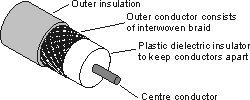Buying the Best TV Antenna Cable
Key pointers for buying the best TV antenna cable to ensure that the performance of the antenna is maximised
Home » Antennas & Propagation » this page
Coax Tutorial Includes:
Coax feeder
Coax specifications overview
Coax impedance
Coax loss / attenuation
Coax power rating
Coax velocity factor
Coax environmental
Coax installation tips
Coax cable types
Tips for choosing right coax cable
Buying TV coax: points to note
The coaxial cable can be just as important as the antenna. Buying the best cable any TV antenna is key to making the most of its performance.
When buying TV cable there are several points to consider. Buy the right cable and the antenna will work to its best. Buy the wrong cable and much of the signal can be lost as it travels from the antenna to the television.
What is coax cable
When looking at buying coax cable for a TV antenna, it is helpful to have an idea of what it is.
Essentially coax cable is what is known as an RF feeder - it carries radio frequency signals from one point to another with the minimum of loss and radiation from the coax.
Note on Coax cable:
Coax cable is used to transfer radio frequency energy from one point to another with the minimum loss. The cable consists of two concentric conductors kept apart by a dielectric material.
Read more about Coax Cable.
The main constituents of the coax cable are the inner conductor, dielectric spacer, outer conductor and the protective sheath as shown below.

showing the inner conductor, dielectric, outer conductor and protective sheath
Key buying pointers
When buying coax cable for a television, it is necessary to ensure the right sort of cable is being bought, and secondly it is necessary to balance cost against the likely benefit to be obtained.
As with most things, the more you pay, the better the product. However there is often a sensible balance to be made and paying too much may not bring any noticeable advantages in some circumstances.
Some of the main things to consider when buying coax cable for a television re the impedance, signal loss, thickness, and the intended application for the coax.
Coax impedance
Coax cable has what is referred to as a characteristic impedance. Basically by keeping all the elements in the system: antenna; coax cable; and the input to the television the same impedance, the best power transfer from one to the next is maintained and in this way the best performance is obtained. Essentially having the right impedance coax cable for the TBV system will ensure the best performance./p>
For domestic television and most VHF FM radio, 75Ω is the standard, i.e. use 75Ω coax for video applications. Coax cable intended for domestic television will always be 75Ω but if you go into a shop where other forms of coax are sold, then you need to check. But just tell the assistant that this is what you need.
Typical widely used 75Ω cables are RG59/U and RG6/U. These have a 22 AWG stranded center conductor to allow for cable flexibility. The common size cable can be easily terminated and is available in 100-, 500- and 1000-foot reels.
Cable loss
The next major aspect to think about when buying coax cable is the level of loss. The higher the loss, the lower the signal level at the television and the poorer the reception will be.
Television coax is normally sold as standard and low loss. The low loss is thicker than the standard coax, and normally it is best to opt for low loss, except possible for short interconnecting leads between different TV boxes like the recorder and so forth - these leads are likely to be bought ready made for possibly cheaper than you can buy the bits. Being short, they won’t introduce much loss.
To get technical, the loss of a coax cable is specified in terms of a certain number of decibels for a given length, often 10 metres, and for a certain frequency.
 Written by Ian Poole .
Written by Ian Poole .
Experienced electronics engineer and author.
More Antenna & Propagation Topics:
EM waves
Radio propagation
Ionospheric propagation
Ground wave
Meteor scatter
Tropospheric propagation
Antenna basics
Cubical quad
Dipole
Discone
Ferrite rod
Log periodic antenna
Parabolic reflector antenna
Phased array antennas
Vertical antennas
Yagi
Antenna grounding
Installation guidelines
TV antennas
Coax cable
Waveguide
VSWR
Antenna baluns
MIMO
Return to Antennas & Propagation menu . . .


